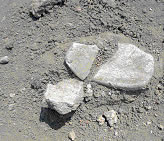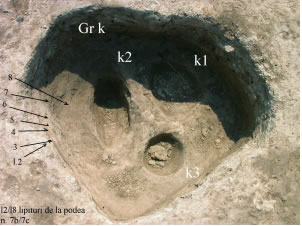

The suspended floor of the house 171-172 was not so large, only 1, 8/1, 9 x 1, 6 m (fig. 4a), so can not belong to a storey. Only on S part we found pottery; so, we believe that this suspended floor may be related with storage area (fig. 4c), or with a bad (such situation have been noticed in other archaeological situations, at Taga: Lazarovici Gh. et alii 2003; 2004; Maxim et alii 2005).
Fig. 4. House 171/172 a) Suspended floor; b) structure
Fig. 4c Pottery under the floor; d) grinding stone The floor we mention has some disturbances (fig. 4a), due to the big beams from his substructure. To the N wall a broken in situ grinding stone have been discovered (fig. 4d).
House 171-172 has a very similar shape with another house earlier investigated at Parţa (platform 166, level 5), were on the E part it was a „bad” (cca. 1,2 x 1,7 m), maybe used for other purposes too. Fragments of walls, soldering of the ceiling, animal bones and shards have been discovered in relation with platform 166. In 2005 we have prepare for investigation some adobes agglomerations belonging to Tiszapolgár complexes (P173-174); most of them has a wooden structure and space between the wood is filled with adobes. These adobes agglomerations are along the walls. We believe they represent the soldering that covers the wooden walls to protect them against wind, rains. Such system is still used in Transylvania on farmer’s wooden houses (our etnoarchaeological investigations, fig. 7a).
Fig. 5. Platform 166
Fig. 6a. House 174; b) House 173; c) Houses 174, 173, 172 When walls have been destroy by fire their plaster are preserved (if not fired, there are very few traces, some time impossible to identify, because they contain clay, earth and organic material).
In our case, the archaeological material was spread. Shards have been discovered under the „bad”, including the grinding stone. More data will be obtained after we will investigate what is under the structure of the complex. House of the deer (fig. 7).Our research continued on all surface of the „block” of houses. Some specific and general situations have been noticed. Some rooms of this dwelling continue from level 7b, while the thickness of the plasters goes until the base of level 7b. Covered with plastic, complexes have preserved very well (fig. 8). Fig. 7a. Râmeţ, Alba district, beams plastered
Fig. 7 b. Deer House area a) general view, b) working aspect ROOM A
Fig. 8. Room A, basic structure, level 7a/6, view to E A Medieval pit destroy the W part of room A (the floor and the inner wall, 1 m S of the deer had) as well as a part of room B. The floor of the first living levels has until now five plaster strata, but in pit k, some fragments show eight strata and our investigation is going on (fig. 9a). Excavations have to be extended to the S.
Fig. 9. House of the Deer: a) pit k, b) pit i; room A Two of the main postholes contain group of three-four posts (pits k, i: fig. 9). In pit i we can observe an older pit (pit ia), with two posts, one take out when pit ib was dug (this last contain three posts, as pit k). Pits with three posts are related with level Parta 6, when a storey is raised for each of the four rooms.
Fig. 10 a) Posts on the wall between rooms A, B; The pits from the storey generally double those of the walls; the interior pits (group of two-three) sustain the wooden structure of the floor; on top of it was the clay plaster. Most of the houses storey have light walls, made by interweaved rods. Such a wall was discovered in 2005, without foundation or clay plaster (Lazarovici, Merlini 2005, fig. 19). Such structures have been discovered on the storey of "block" of houses P42 and P8 (Lazarovici et alii 2001, I.2, p. 100). |
||||
|
||||
















